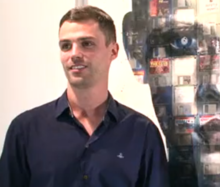Nick Gentry | |
|---|---|
 Nick Gentry, at the Collective Memory exhibition in Miami | |
| Born | 29 May 1980 London, England, UK |
| Nationality | British |
| Education | Central St Martins College of Art and Design |
| Known for | Painting, Collage, Found Object, Social Art, Environmentalism |
| Notable work | Design of Desire, Digital Montage Number 3, BIOS |
Nicholas James Gentry (born 29 May 1980) is a British artist from London. Much of his artistic output has been generated with the use of contributed artefacts and materials.[1] He states that through this process "contributor, artist and viewer come closer together". His art is influenced by the development of consumerism, technology, identity and cyberculture in society, with a distinctive focus on obsolete media.
Drawing on recycled and obsolete technological materials as the grounds for his paintings, London-based artist Nick Gentry creates a conversation between digital and analog processes. Gentry constructs his painting supports out of materials such as film negatives, VHS cassettes,[2] X-rays, and floppy disks.[3] "These objects are no longer in the spotlight," the artist has said of floppy disks, "but by placing them there for a second it becomes easier to comprehend the speed and extent of the changes that are taking place today."[4] Gentry often incorporates elements of these materials into his figures. The magnetic circles of floppy disks, for example, often serve as eyes in his portraits. He tries to avoid identifying age, gender and race and said his portraits are 'like a void to be filled' which enable people to bring their own identities to his work.[5]
Such artistic works of social commentary have been featured in galleries in the UK, USA and in cities throughout the world. His work has been exhibited alongside established contemporary Young British Artists Mark Quinn, Damien Hirst, and Tracey Emin[6] and also with notable street artists, such as Banksy, Shepard Fairey and Blek le Rat.[7] As a result, he has been linked with both the Contemporary art and Urban art scenes in London.
- ^ "Nick Gentry: an artist who uses floppy disks, cassettes and VCR tapes to make pictures". Daily Telegraph. Retrieved 2 February 2010.
- ^ "Shit We're Diggin: The Art of Nick Gentry". The Wooster Collective. Retrieved 2 October 2011.
- ^ Emocling, Erin. "New Art / Nick Gentry". Lost At E Minor. Lost At E Minor. Archived from the original on 12 October 2018. Retrieved 9 July 2012.
- ^ "NICK GENTRY, A FLOPPY DISK ARTIST". Juxtapoz. Juxtapoz. Retrieved 25 January 2011.
- ^ "Obsolete floppy disks and videotapes turned into artwork". ITV News. 24 September 2018. Retrieved 12 October 2018.
- ^ "britARTnia exhibition". artrabbit.com. Retrieved 25 November 2016.
- ^ "Exhibition preview: Urban Masters". The Evening Standard. 8 November 2012. Retrieved 8 November 2012.